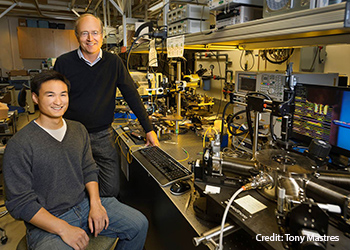
Alan Liu and Professor John Bowers at UCSB
For many years, optical integrated circuits have offered a fast, energy efficient alternative to traditional copper—but they are much more expensive to manufacture. Now, materials researchers at the University of California Santa Barbara (U.S.A.) have achieved record performance on quantum dot lasers grown on silicon, which holds promise toward low cost, large scale photonic integrated circuits (Appl. Phys. Lett. 104, 041104).
The 1.3 µm indium arsenide (InAs) quantum dot lasers were grown epitaxially on silicon, which enables manufacturing on larger substrates at lower costs and therefore greater economies of scale than traditional wafer-bonded layers on III-V substrate.
A collaboration between Santa Barbara’s John Bowers and Arthur Gossard demonstrated record continuous wave lasing thresholds as low as 16 mA, output powers of more than 176 mW, and lasing at temperatures as high as 119 degrees Celsius. According to the team’s paper, these are the highest reported CW output powers and lasing temperatures ever for lasers on silicon.
While laser structures expitaxially grown on silicon show a high density of crystal imperfections called “dislocations,” which makes the technique unappealing for commercial purposes, the team showed that their InAs quantum dot lasers show repeatable high performance in spite of these dislocations. This is because they are less sensitive to non-radiative defects than quantum well devices.
Graduate student Alan Liu, first author on the paper, says, “These results are a very promising step towards a low cost, large scale photonic integration platform. We are now working to improve the laser performance and integrate these lasers with other optoelectronic devices."
